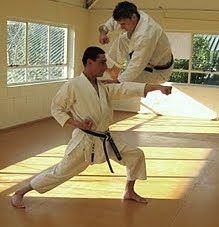 In addition to training in the general class at the Christchurch Shotokan Karate Club
In addition to training in the general class at the Christchurch Shotokan Karate Club  (CPIT dojo) here is the current instructors class training. Please note: the exception of the tokui-gata, which of course dependent on the individual.
(CPIT dojo) here is the current instructors class training. Please note: the exception of the tokui-gata, which of course dependent on the individual.II. Stationary kihon: (1) Sanbon-zuki (hachinoji-dachi); (2) Hidari jodan kizami-zuki kara migi chudan gyaku-zuki; (3) Migi jodan kizami-zuki kara hidari chudan gyaku-zuki; (4) Hidari chudan maeashi mae-geri kara migi jodan mae-geri; & (5) Migi chudan maeashi mae-geri kara hidari jodan mae-geri. – 50 maximum speed repetitions of “1-3” for a total of 250 tsukiwaza and 30 repetitions of “4 & 5” for a total of 120 keriwaza.
III. Ido-kihon: (1) Sanbon-zuki; (2) Jodan age-uke kara mae-geri soshite chudan gyaku-zuki; (3) Chudan soto-uke kara yori-ashi (kiba-dachi) yoko empi-uchi, uraken yokomawashi uchi
 soshite chudan gyaku-zuki; (4) Chudan shuto-uke (kokutsu-dachi) kara mae-ashi mae-geri soshite nukite; (5) Chudan uchi-uke kara kizami-zuki soshite gyaku-zuki; (6) Tenshin gyaku-zuki (Kaiten-shinagara gedan-barai kara chudan gyaku-zuki); (7) Ren-geri: Chudan mae-ashi mae-geri kara mae-geri; (8) Chudan mae-ashi mawashi-geri kara mawashi-geri; (9) Ushiro-geri; & (10) Yoko-keage ashi o kaete yoko-kekomi (kiba-dachi). – A minimum of 10 reps of every technique with maximum speed.
soshite chudan gyaku-zuki; (4) Chudan shuto-uke (kokutsu-dachi) kara mae-ashi mae-geri soshite nukite; (5) Chudan uchi-uke kara kizami-zuki soshite gyaku-zuki; (6) Tenshin gyaku-zuki (Kaiten-shinagara gedan-barai kara chudan gyaku-zuki); (7) Ren-geri: Chudan mae-ashi mae-geri kara mae-geri; (8) Chudan mae-ashi mawashi-geri kara mawashi-geri; (9) Ushiro-geri; & (10) Yoko-keage ashi o kaete yoko-kekomi (kiba-dachi). – A minimum of 10 reps of every technique with maximum speed.IV. Kumite: (a) Jiyu ippon kumite (jodan, chudan, mae-geri, yoko-kekomi, mawashi-geri & ushiro-geri); & (b) Kaeshi ippon kumite (as per jiyu-ippon kumite attacks). – Changing partners at least three times for both forms of kumite.
VI. Calisthenics: Asai-ha Shotokan-ryu kihon taiso and the typical impact work. The sessions are concluded with isometric stretches and a variety of comprehensive warm downs.
© André Bertel. Christchurch, New Zealand (2012).
No comments:
Post a Comment